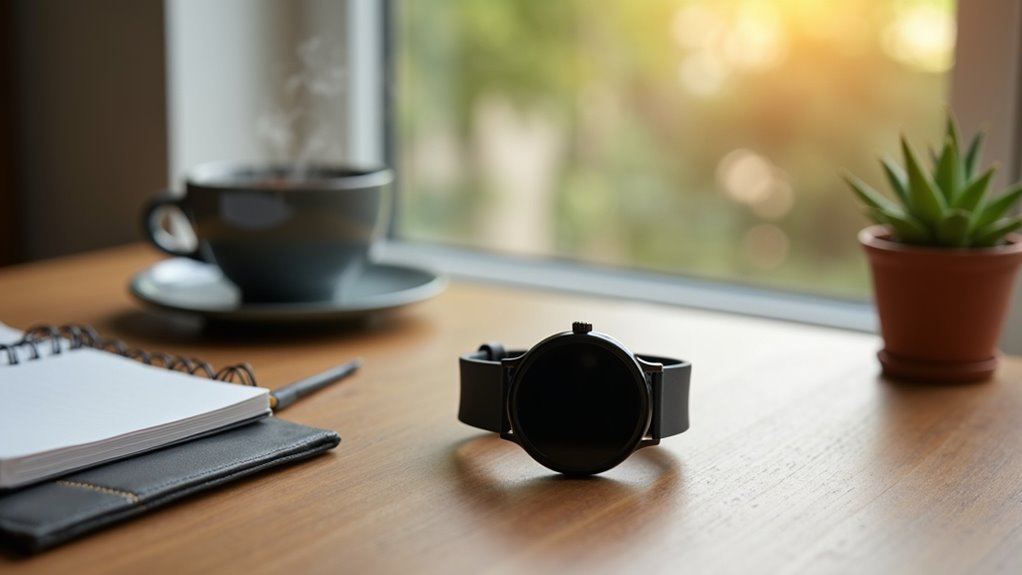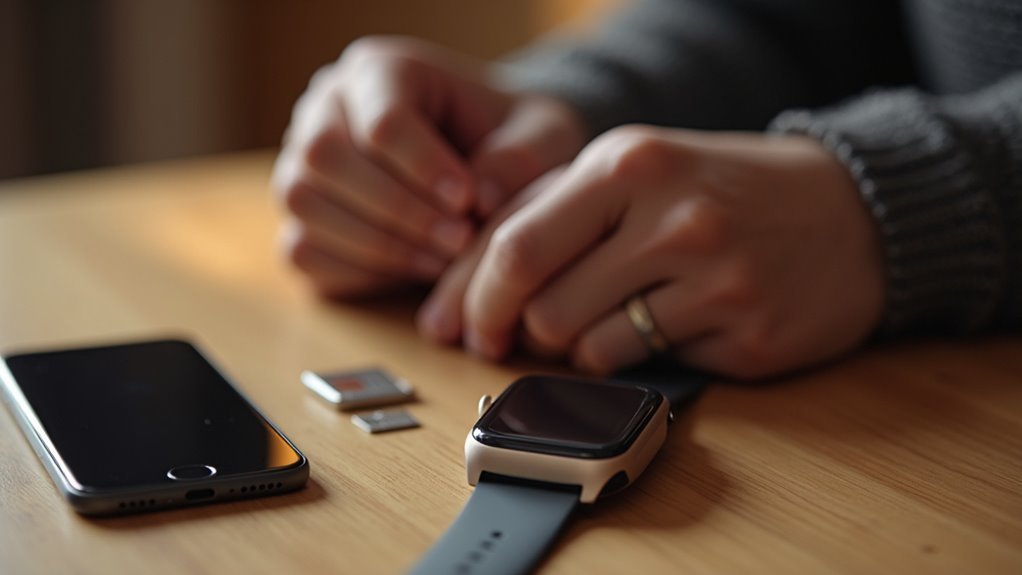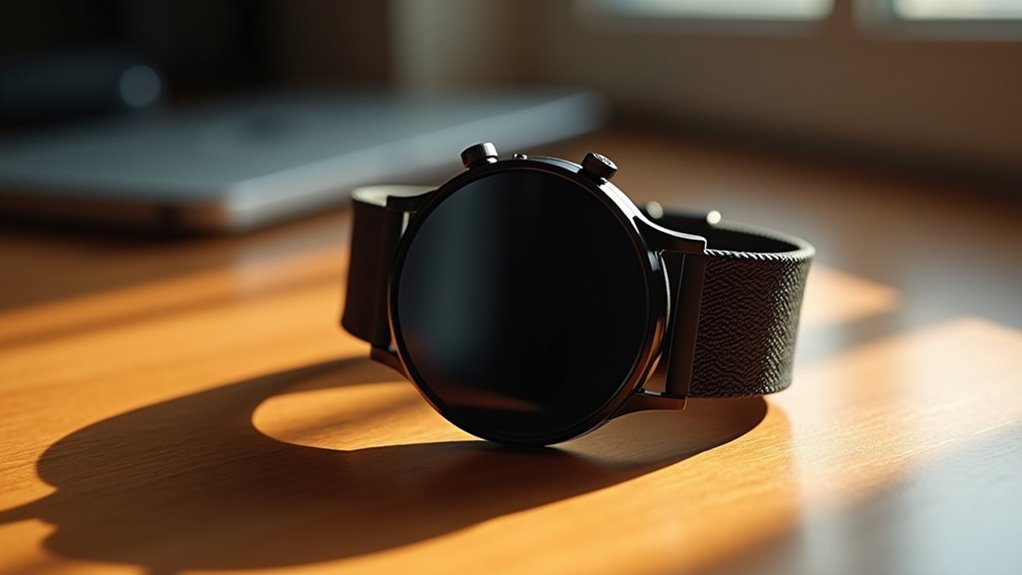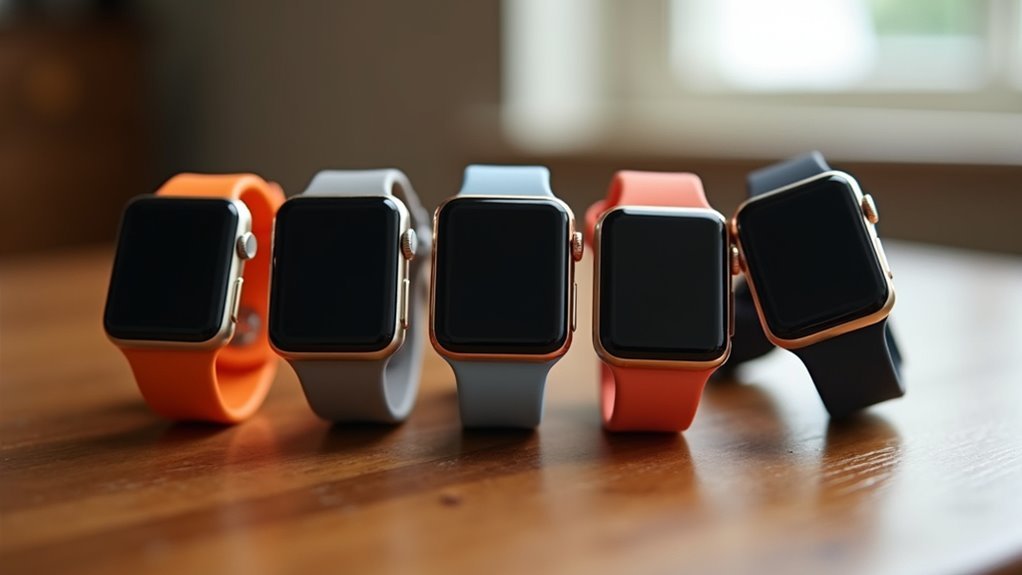You can now track your stress hormones through cutting-edge wearable sensors that monitor cortisol via sweat and saliva in real-time. The top options include passive-sweat cortisol patches using nanoporous structures, saliva-based electrochemical devices with antibody detection, multi-biomarker smartwatches tracking both cortisol and melatonin, molecularly imprinted polymer sensors achieving 0.036 nM detection limits, and AI-powered personalized stress management systems. These breakthrough technologies deliver thousands of weekly measurements without blood draws, providing instant cortisol readings that’ll transform how you understand your body’s stress responses.
Real-Time Passive-Sweat Cortisol Sensors for Continuous Stress Monitoring

While traditional stress monitoring requires invasive blood draws or saliva collection at specific moments, real-time passive-sweat cortisol sensors revolutionize how you can track your body’s stress responses throughout the day.
These innovative devices use nanoporous structures to detect cortisol in ultra-low sweat volumes, meaning you don’t need to work up a heavy sweat for accurate readings.
You’ll simply apply a flexible patch to your arm or leg, and the sensor passively collects sweat through natural secretion.
The device employs selective membranes and molecularly imprinted polymers to identify cortisol while blocking interference from ions like sodium and potassium.
Within seconds of sweat contact, you’ll receive real-time cortisol measurements spanning nanomolar to micromolar concentrations, perfectly capturing your physiological stress fluctuations. These sensors also track additional vital biomarkers like melatonin and inflammatory markers to provide a comprehensive view of your stress and metabolic health.
Saliva-Based Electrochemical Cortisol Detection in Wearable Devices
Although sweat-based sensors offer continuous monitoring advantages, saliva-based electrochemical cortisol detection provides superior accuracy for stress assessment in wearable devices. You’ll find these sensors use antibodies or aptamers attached to electrodes that create measurable electrical signals when cortisol binds. The technology achieves detection limits as low as 0.1 ng/mL, matching physiological cortisol ranges in your saliva.
However, you’ll face challenges with saliva collection compared to passive sweat monitoring. The sensors require microfluidic channels to optimize saliva contact with electrodes, and you’ll need patch-like devices for intraoral or perioral placement.
Gold nanoparticles enhance sensitivity, while reference electrodes compensate for environmental noise. These systems integrate wireless transmission for real-time stress monitoring, though maintaining sensor reusability remains technically challenging. Saliva-based detection offers the advantage of measuring free cortisol levels through passive diffusion, providing a more accurate representation of bioactive hormone concentrations.
Multi-Biomarker Smartwatch Integration: Cortisol and Melatonin Tracking

Since traditional single-biomarker wearables can’t capture the complex interplay between stress and sleep hormones, multi-biomarker smartwatch integration now tracks both cortisol and melatonin simultaneously.
You’ll get continuous monitoring through advanced passive sweat-sensor technology that requires only microliters of sweat—no blood or needles needed.
These devices deliver up to 3,000 weekly measurements per biomarker, giving you real-time insights into stress hormone spikes and melatonin sleep readiness.
You can observe how your diet, exercise, and lifestyle choices impact your hormonal patterns throughout the day. The monitoring reveals that melatonin levels change within 20 to 30 minutes while cortisol peaks 15 to 30 minutes after stress onset.
The technology stems from over a decade of research with 500,000+ biomarker readings and collaborations with institutions like UCLA.
You’ll understand your circadian rhythms better while sharing precise data with clinicians for personalized treatment adjustments.
Advanced Molecularly Imprinted Polymer Technology for Rapid Cortisol Analysis
As stress monitoring demands grow more sophisticated, molecularly imprinted polymer (MIP) technology delivers breakthrough precision in cortisol detection that wasn’t possible with conventional biosensors.
You’ll benefit from sensors achieving detection limits as low as 0.036 nM, perfectly suited for physiological cortisol levels in your body.
These advanced sensors use electropolymerization techniques with optimized monomer concentrations and template ratios to create cortisol-specific binding sites.
Electropolymerization creates molecularly tailored binding sites through precise monomer optimization, delivering unmatched cortisol-specific detection capabilities for advanced biosensing applications.
You’ll get rapid results within minutes through differential pulse voltammetry, enabling real-time stress monitoring.
The technology’s selectivity guarantees accurate readings by discriminating against similar steroid hormones.
What’s particularly exciting is MIP sensors’ integration potential with portable devices for non-invasive cortisol screening in your sweat or saliva, advancing wearable health monitoring capabilities considerably. Unlike traditional antibody-based sensors that degrade quickly, MIPs maintain their performance with long shelf life that significantly reduces replacement frequency and maintenance costs.
Personalized Stress Management Through Wearable Cortisol Pattern Recognition

While traditional stress monitoring relies on broad physiological indicators, wearable cortisol sensors now reveal your body’s most precise stress signature through continuous hormone tracking.
These devices analyze your unique cortisol fluctuations to identify personalized stress patterns linked with your circadian rhythms and psychological states.
Your cortisol data combines with other physiological signals through AI algorithms that detect stress episodes and trigger targeted interventions.
This creates adaptive feedback mechanisms that respond to your specific needs:
- Guided breathing prompts during elevated cortisol periods
- Relaxation alerts based on your stress thresholds
- Early detection of mental health issues through pattern changes
- Personalized stress management routines via mobile apps
- Real-time intervention triggers tailored to your physiology
Advanced wearable patches now collect cortisol through sweat analysis, providing immediate feedback without requiring invasive blood draws or laboratory processing delays.
This personalized approach transforms generic stress management into precision wellness strategies.
Frequently Asked Questions
How Much Do Cortisol Monitors Typically Cost Compared to At-Home Test Kits?
You’ll find cortisol monitors typically cost more upfront than at-home test kits due to advanced technology. Test kits range from $50-$400, while instant monitors command premium pricing but aren’t widely available.
Can Cortisol Monitors Be Used by People With Sensitive Skin or Allergies?
You can use cortisol monitors with sensitive skin since they’re designed with gentle, flexible materials and non-invasive sweat collection. However, you should patch test first as no device guarantees zero allergic reactions.
How Often Should I Calibrate My Wearable Cortisol Monitoring Device for Accuracy?
You should calibrate your wearable cortisol monitor according to manufacturer instructions, typically daily to every few days. Conduct baseline normalization after setup and recalibrate if you notice sensor drift or environmental changes.
Are Cortisol Supplements Safe to Take While Using Continuous Monitoring Devices?
You can safely take cortisol supplements while using continuous monitoring devices. They’re generally safe together, but you’ll want to consult your healthcare provider first to avoid potential medication interactions.
What Is the Typical Battery Life for Wearable Cortisol Monitoring Smartwatches?
You’ll typically get several days of battery life from wearable cortisol monitoring smartwatches, though it’s shorter than standard smartwatches due to advanced sensor technology requiring more power for continuous biomarker tracking.





Leave a Reply